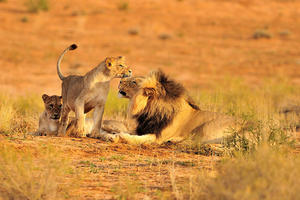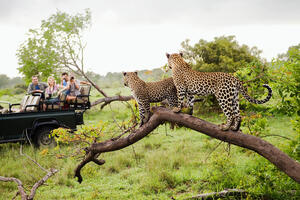An Interview with a Safari Park Ranger at Kruger National Park
Ever wondered what it's like to be a safari park ranger? Or just want to know what you can expect when going on safari in South Africa, or more specifically, on safari in Kruger National Park? If so, read on. We sat down with Thornybush Game Reserve park ranger Sean van Graan to find out more, including why he became a ranger, what a day in the life of a ranger is like, and his most memorable wildlife sightings to date…
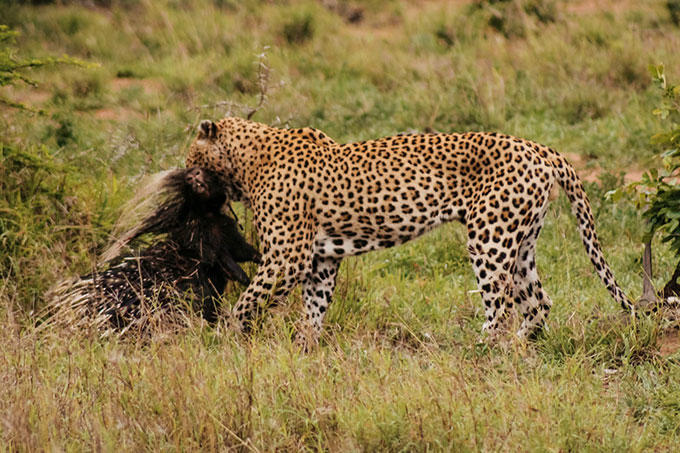
Leopard and Porcupine - Image: Emily Cater
Leopard and Porcupine
Image: Emily CaterWhat made you want to become a safari ranger and how long have you been doing it for?
I always loved the outdoors, I grew up on a game farm where we had most of what you can see at Thornybush except for three of the Big 5, namely elephant, rhino and lion. After school I worked in the city for a telecommunications company, where I had to commute over 90 miles a day back and forth to work. One day, I got stuck in traffic for four hours on the way to work while sitting in my car, and it was then that I made the decision that that would be the last day that it would happen to me again. I got to the office and handed in my 24-hour resignation right there and then. I took a year-long break on the farm to clear my head and decide what I would be doing for the rest of my life, and that is where I learned about guiding. I have been doing it for 20 years now.
Describe your typical day as a safari ranger…
We start pretty early; most days I am up at 4am and I'm at the lodge at 5am. I will generally have a cup of coffee with the guests while we plan the drive ahead and decide which species we will target for that drive. There are two drives per day, one in the morning and then a sunset safari in the afternoon. We also do walking safaris if the guests prefer to see the finer details of the African bush.
Inbetween drives, there's always something to do. We often have to go and clear roads as the elephants push trees down over them. We also have some occasional admin that needs to be done, but the nice thing about being a guide is that there is not a lot of it.

On a game drive at Thornybush Game Reserve - Image: Emily Cater
On a game drive at Thornybush Game Reserve
Image: Emily CaterWhat do you think make the game drives at Thornybush stand out?
For me, it is the quality of the sightings and the professionalism of the guides that work at Thornybush. And if you think of it the two go hand in hand – our animals on the reserve are very relaxed around the vehicles and that offers the guests a once in a lifetime opportunity to become part of the day-to-day life of the animals. The reason why they're so relaxed is because of the ethics of each guide that works on the reserve. They respect the animals and the animals’ personal space which in return makes the animal relaxed and feel totally comfortable with us being there as observers.
Another thing about Thornybush is the diversity of fauna and flora that you find on the reserve. In my opinion it is one of, or even the best, reserve in South Africa.
What tips do you have for a customer doing a safari for the first time?
Undertake proper planning!! I would suggest at least a three-night visit to the reserve. Decide what you want to see; if you want to see animals and their young then plan a trip over the rainy season, but the obvious downside to that is that you might have rain during your stay. My absolute favourite time is over winter, it is drier so the animals are more concentrated around waterholes and the vegetation is not that dense making game viewing a bit easier. But whatever you decide, Thornybush is a great place to see animals throughout the year. Always expect the unexpected.
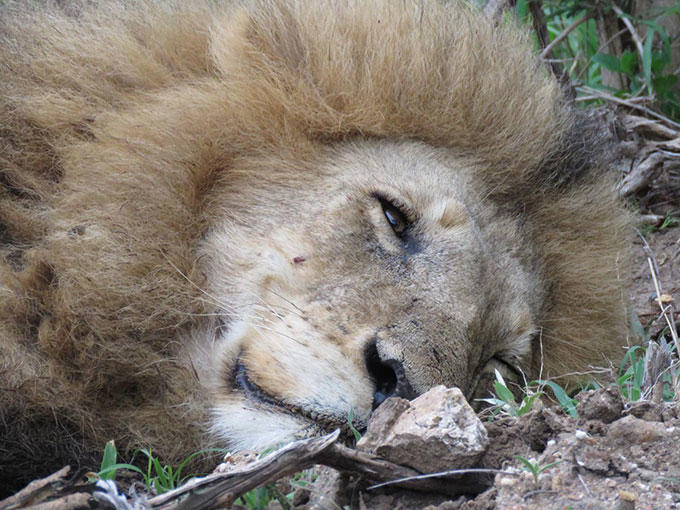
Sleeping lion - Image: Emily Cater
Sleeping lion
Image: Emily CaterWhat animals are customers most likely to see during a game drive here?
The reserve is home to the Big 5 (elephant, rhino, buffalo, lion, and leopard) and we are fortunate to see them on a regular basis. But it's not all about the Big 5; there are also numerous antelope species – 147 to be precise – to be found in the reserve alongside giraffe, zebra, blue wildebeest, impala and kudu, and we also have hippo, hyena, cheetah, and crocodiles here in the reserve. There are about 507 bird species in and around the property too.
What has been the best/most memorable sighting you’ve ever had?
Wow… over the last 20 years there have been many!! But I must say all of my best sightings have been at Thornybush, and I am not just saying this because I'm biased. One that stands out and which I rate as the best happened to me about two months ago. We were on a morning drive and found some lion tracks so decided to follow them. It took us about two hours to track these lions through the bush and over many miles, we finally found the pride lying down under some trees relaxing after walking some distance during the night. We were all so pleased with ourselves, even the guests because we got them involved with the whole process of tracking the lions. After a few minutes, I noticed the one lioness there was chewing on something and playing with whatever she was chewing. We drove over to find her busy trying to kill a pangolin!!! The sighting went from being great to the best of my life in a few seconds!! Pangolins are anteaters and nocturnal animals. They are extremely endangered and protected in South Africa, as they get hunted for their scales that are sold on the black market and in Asia as traditional medicine. Just to put it in perspective, I have only seen six over my 20-year career as a guide. We sat there for about 20 minutes rooting for the pangolin, they are perfectly designed for a life in Africa and its big cats! When they feel threatened, they roll up into a ball covering their head and soft underbelly with the scales on their bodies, making them nearly impossible to eat. After a while the lion got bored and moved away, leaving a very stressed and scared but alive pangolin behind.
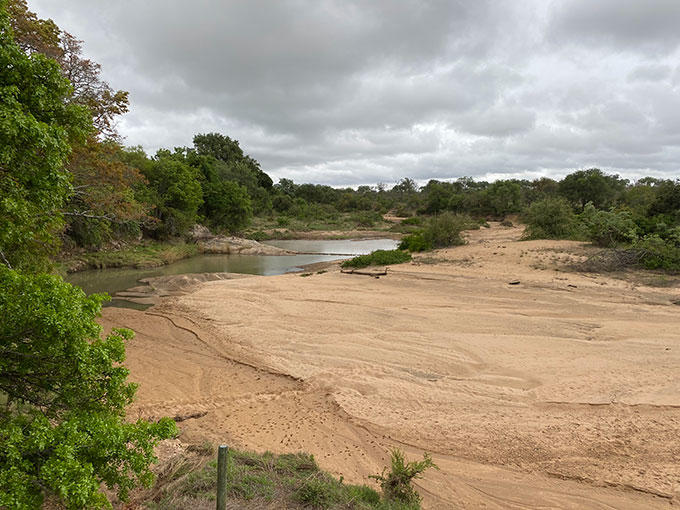
Thornybush dry river - Image: Emily Cater
Thornybush dry river
Image: Emily CaterWhat kind of things do rangers and trackers listen and look out for when it comes to finding animals?
We use the tracks that animals leave behind to find them, that is why a tracker is so valuable to the team. They have years of knowledge and skills that they use to track the animals we are looking for.
The techniques include listening to bird and animal alarm calls, general animal behaviour, as well as the body language of antelope to find the predators.
How important is the relationship between the tracker and the ranger and why?
It is extremely important. We spend at least eight hours together a day on a six-week work cycle. We spend more time together than we do with our families. We have to work together as one unit to find the animals for the guests and to make it an unforgettable experience for them.
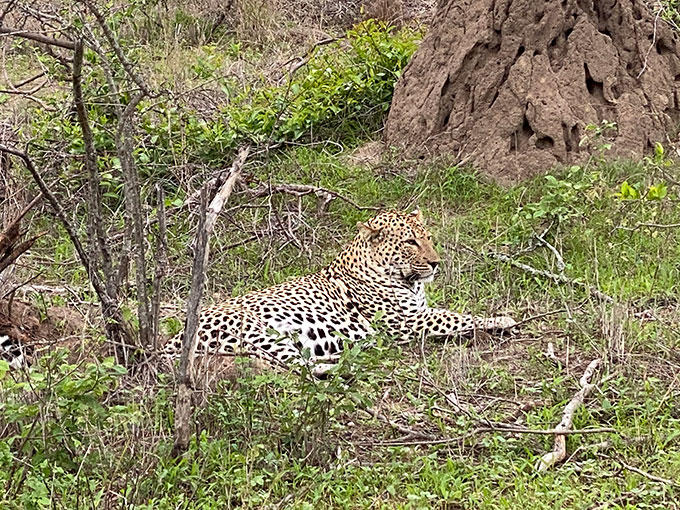
Leopard
Leopard
What do you see for the future of safari in terms of conservation? What, if anything, would you like to see more of?
There is a very bright future for the industry. The more the tourism industry grows the more valuable reserves become. We have noticed the increase of private landowners incorporating their private land (agricultural and game farms) into game reserves across South Africa. Most farms that are privately owned are too small to house the Big 5 so incorporating private patches of land into neighbouring Big 5 reserves makes it possible for the landowners to open a lodge and benefit from ecotourism that is attracted by seeing the Big 5 and other animals in their natural environment. This in return creates jobs for the local community and awareness of the benefits of protecting natural areas. But the main benefit of this is that you are returning land back to the animals and creating vast areas of natural habitat. My dream is to have areas as big as the Kruger National park across South Africa that is driven to protect our wildlife for future generations.
Finally, what’s your favourite thing about the job and Thornybush?
The animals are my absolute passion, and the intrigue that you will never know what you will find around the next corner. Also the people. You meet so many different cultures and personalities from across the world. I really admire the professionalism of the Thornybush Collection and the Thornybush Game Reserve, and what they offer the guests. In all honesty, this is the best reserve and one of the best companies in the industry.
Feeling Inspired? Chat to our Lovely Travel Consultants Today!
Flight Centre’s Travel Consultants really know their stuff when it comes to creating bespoke itineraries. Get in touch below, and let us tailor-make it easy


